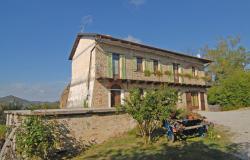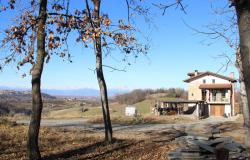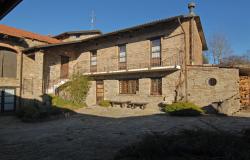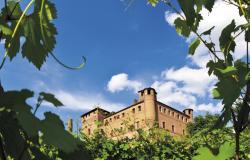Soft and sweet, savoury and hard, mouth-melting and strong. Italy makes excellent cheeses all year round, but each season brings delicious surprises. Spring is the time for caprini, as goats resume sufficient milk production in February and March, but also many sweet cow’s milk and ewe’s milk cheeses, which get their richness and herby notes from the lush March and April pastures. Some of these are fresh and taste of the warming sun, April rains and new grass. Many are aged and have the pungent, almost piquant flavour of prolonged ripening in dark cellars. And virtually all of them make their way into the first picnics of the year, to be eaten alongside peas and broad beans, and washed down with a glass of wine. To help you make the most of the season, we have picked three of the very best cheeses you shouldn’t miss.
Cacioricotta del Salento, Puglia
 Spring and summer are the time to make cacioricotta, a traditional cheese from Puglia. As the name implies, it is a ‘mixed’ cheese—the milk from pasture-fed ewes, goats or cows is worked by combining ricotta and traditional cheesemaking methods. Heated to 85-90 degrees, it is left to cool down to 37 degrees before adding the rennet. This causes both milk and whey to coagulate. The end result is a soft, candid, ricotta-like cheese, which becomes semi-hard and straw yellow if aged for two or three months. Eaten fresh, it is fragrant, salty and slightly acidic. When aged, it becomes tangier and is perfect both on its own or grated on pasta (especially orecchiette). Cacioricotta can taste stronger in late spring and summer when the pastures become drier.
Spring and summer are the time to make cacioricotta, a traditional cheese from Puglia. As the name implies, it is a ‘mixed’ cheese—the milk from pasture-fed ewes, goats or cows is worked by combining ricotta and traditional cheesemaking methods. Heated to 85-90 degrees, it is left to cool down to 37 degrees before adding the rennet. This causes both milk and whey to coagulate. The end result is a soft, candid, ricotta-like cheese, which becomes semi-hard and straw yellow if aged for two or three months. Eaten fresh, it is fragrant, salty and slightly acidic. When aged, it becomes tangier and is perfect both on its own or grated on pasta (especially orecchiette). Cacioricotta can taste stronger in late spring and summer when the pastures become drier.
Another Pugliese cheese worth trying is the Caciocavallo Podolico del Gargano. Considered the Parmesan of the South, this cheese, which is made from the milk of the local Podolica cow, is straw yellow in colour, with a hard texture and a strong, markedly pungent flavour. Perfect served with full-bodied red wines.
Caprino Ossolano, Piedmont
 Stubborness, perseverance in the face of adversity and a good pinch of good luck saved the Caprino Ossolano from oblivion. Once very common in the Val d’Ossola, the mountainous wilderness on the border between Piedmont and Switzerland, where it had been made for centuries, caprino production dwindled to nothing over the course of the 20th century. In recent years, however, the obstinacy of a few cheesemakers—many of whom hailed from neighbouring Lombardy—brought this delicious cheese back to life. Caprino Ossolano, locally called furmagit at crava, is made from raw goat’s milk between March/April and October/November. The milk is acidified, then, when it reaches a temperature of 18 to 20 degrees, very little rennet is added. The curd is placed in a mould and dry-salted. Aged for three days, it is soft but firm, and cream white under a thin white rind. If ripened (for up to 40 days) the rind becomes straw yellow. Caprino ossolano has a light, fresh flavour and is excellent served with country bread and a glass of Ossola wine.
Stubborness, perseverance in the face of adversity and a good pinch of good luck saved the Caprino Ossolano from oblivion. Once very common in the Val d’Ossola, the mountainous wilderness on the border between Piedmont and Switzerland, where it had been made for centuries, caprino production dwindled to nothing over the course of the 20th century. In recent years, however, the obstinacy of a few cheesemakers—many of whom hailed from neighbouring Lombardy—brought this delicious cheese back to life. Caprino Ossolano, locally called furmagit at crava, is made from raw goat’s milk between March/April and October/November. The milk is acidified, then, when it reaches a temperature of 18 to 20 degrees, very little rennet is added. The curd is placed in a mould and dry-salted. Aged for three days, it is soft but firm, and cream white under a thin white rind. If ripened (for up to 40 days) the rind becomes straw yellow. Caprino ossolano has a light, fresh flavour and is excellent served with country bread and a glass of Ossola wine.
Another goat’s cheese worth trying is the compact, slightly tangy Robiola di Roccaverano, which recently won a prize for the best chèvre cheese in the birthplace of chèvres—France.
Pecorino baccellone Toscana
 The name says it all. Pecorino baccellone means ewe’s milk cheese in a pod, and that’s because this pecorino, which originally hails from Tuscany’s Pisa province, is usually eaten together with broad beans. Unlike most Italian pecorini, the baccellone is not aged. The milk from ewes fed on verdant Spring pastures is heated, salted and curdled with calf rennet. It is placed in moulds to let the whey drain, then cured in brine for a day. After that, it is left to ripen in a cold, damp cellar for two to five days. As a result, baccellone is soft, white and slightly crumbly, with a fresh taste that is far more delicate than other pecorini—although it has a markedly salty note and hints of ewe’s milk pungency. Only made between March and June, this cheese is the quintessential Easter Monday picnic snack.
The name says it all. Pecorino baccellone means ewe’s milk cheese in a pod, and that’s because this pecorino, which originally hails from Tuscany’s Pisa province, is usually eaten together with broad beans. Unlike most Italian pecorini, the baccellone is not aged. The milk from ewes fed on verdant Spring pastures is heated, salted and curdled with calf rennet. It is placed in moulds to let the whey drain, then cured in brine for a day. After that, it is left to ripen in a cold, damp cellar for two to five days. As a result, baccellone is soft, white and slightly crumbly, with a fresh taste that is far more delicate than other pecorini—although it has a markedly salty note and hints of ewe’s milk pungency. Only made between March and June, this cheese is the quintessential Easter Monday picnic snack.
Another Spring pecorino worth trying is the Canestrato Crotonese, from Calabria, which is aged for up to two years. A dark yellow rind hides a hard, cream white cheese with a pungent flavour, which is traditionally eaten at Easter with raw broad beans and red wine.














